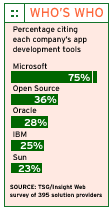SAP, Microsoft, Sun Bring Tools To The Masses
SAP, for one, is building a development environment that will let noncoders create applications that mine information from corporate data sources, said Shai Agassi, executive board member at SAP, Walldorf, Germany.
The new offering, code-named GUI Machine, is expected to be released in October and can be used as part of SAP's NetWeaver integration and application development program, which supports Sun Microsystems' J2EE and Microsoft's .Net.

End users will be able to connect and define a number of business objects via a Web browser interface that can be converted into a working application,all without knowing the intricacies of Java, Agassi said.
Sun and Microsoft, too, are close to enabling line-of-business executives and solution providers to collaborate with corporate developers on application development.
Microsoft is developing a technology, code-named Whitehorse, for the Whidbey release of Visual Studio that will simplify how developers and decision-makers collaborate, said Eric Rudder, senior vice president of servers and tools at Microsoft, Redmond, Wash.
Whitehorse resembles BEA Systems' WebLogic Workshop, which takes the abstraction out of complex Java code through visual modeling of workflows, said one solution provider, who requested anonymity.
Microsoft, whose drag-and-drop Visual Basic and BizTalk business orchestration features have paved the way to programming for the corporate masses, is also developing its own visual modeling paradigm based on UML that's expected to be bundled with the post-Whidbey release of Visual Studio, code-named Orcas, sources said.
Microsoft's efforts won't eliminate the need for programmers but will enable corporate decision-makers and developers to codevelop apps, said David Stutz, formerly a programmer at NeXT Computer and Microsoft. "Tools that enable nonprogrammers to create useful applications are a [Holy Grail] that's been sought for years," Stutz said. "The need for programming craftspeople won't disappear anytime soon, but successes such as the Web app model and sharing of software components have shown us that the amount of custom programming can be vastly reduced."
Sun, Santa Clara, Calif., plans to go up against SAP and Microsoft with Project Rave for Rapid Application Development, which is designed to allow developers to build Web- and database-driven Java apps quickly, Sun executives said. Rave was announced in June 2003 and is slated to ship sometime in 2004.
The next version of J2EE, code-named Tiger, is also aimed at simplified app development, Sun executives said. "For J2EE 1.5 we're going to use language features like metadata and generics to make it much simpler to develop J2EE applications," said John Fowler, CTO of Sun. "You can take a whole bunch of complex Java code and hide it behind the templates so that what people see is a very simple expression of what they want to do. This will open [things] up to people who don't know the language as well."
Marc Maselli, president of Back Bay Technologies, a Java solution provider based in Boston, approves of Sun's efforts to bring app development to nonprogrammers.
"I don't think Java itself is going to include classes and methods to avail itself to business-process designers and other nonprogrammers, but certainly the Java tools market ... is doing everything it can to bring its tools on par with Microsoft's Visual Studio," Maselli said.
Added Rob Helm, an analyst at Directions on Microsoft: "Opening programming to business users has been a longtime dream for Microsoft, but I'd put the dream of end-user programming up there with speech recognition. It keeps getting closer every year, but we haven't had the kind of breakthroughs that would make it a mass technology."
ELIZABETH MONTALBANO contributed to this story.